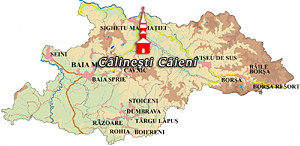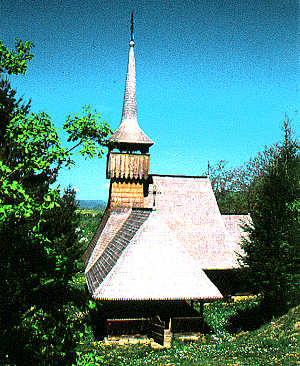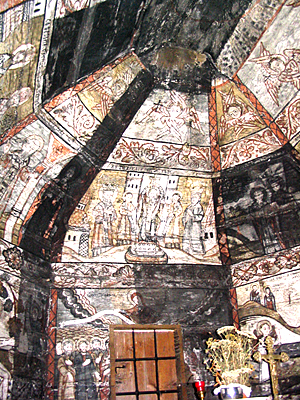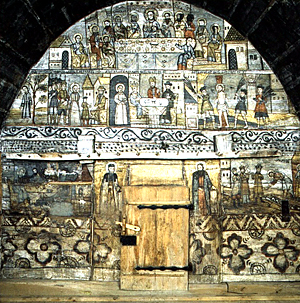Calinesti Caieni Church

Year built: 1630
Location: Călineşti is situated in the valley of the Cosău River, at the foot of Gutâi Mountains, south of Sighetu Marmaţiei.
Summary: The wooden church dedicated to the Birth of the Holy Virgin is in Căieni, the eastern side of the village. It stands on a cemetery hill, in a relatively isolated position with an open view towards the village.

Each wall is built with only five oak beams, but the section of each beam is nearly half a metre. The beams are tied with wooden pegs and the corners are joined in an old technique.
Initially, the plan of the church was the traditional one: rectangular pronaos and naos with a polygonal chancel. At the beginning of the 19th century, the church was modified drastically. The whole north wall of the building was moved further north by three metres, which resulted in the lopsided silhouette of today. The new wall was made of fir beams, and naturally the wall paintings of the 18th century were destroyed. At the same time, the unusually large porch was added in front of the entrance on the south façade. The massive entrance door is impressive due to its size and proportions. A cross carved on the lintel is its only decoration.
A roof with single eaves covers the whole structure, but both the chancel and the porch have their own slightly lower roofs. The tower seems very short, although originally it was well-proportioned. The widening of the body of the church meant also that the roof ridge was raised, and now it starts right under the small tower balcony. The original proportions are visible on the west and south sides.

The original floor of the church was made of trodden clay, but the present floor is made of wooden planks for the pronaos and most of the naos. The chancel and the area just in front of the iconostasis, used by the priests, are paved with stone slabs. The slabs are slightly raised and form a platform that delimits that sacred space from the laic space in front of it. Above the platform, two beams also mark the same separation.
There are only decorative motifs and some Seraphs visible on the vault of the chancel. On the walls, on register I are the standing figures of The Holy Hierarchs holding books in their hands, against architectural background. Just above the east window is The Descent from the Cross.

The naos is topped with a tall barrel vault. On it is painted God the Father, with one Seraph above his head and another one at his feet, which is the way the Trinity was initially represented.Up on register I, on the south side of the vault are five scenes from Genesis, some of which are legible, such as The Creation of Adam, The Tree of Good and Evil, and The Banishment from the Garden of Eden. On the north side of the vault are scenes from the Old Testament, Lamech Speaking to His Women, Cain Killing Abel, Eve Spinning Wool, Adam Tilling the Earth, God Speaking to Adam, and Lamech Killing Cain.
The iconostasis was painted by the famous local painter of wooden churches, Alexandru Ponehalschi, in 1764, as were all the original mural paintings inside the whole church. The frontal perspective of the scenes, and the simple architectural backgrounds that simply suggest volumes, show a style that was adapted to small surfaces. It almost reminds of miniatures made for manuscripts. The iconostasis has two nicely carved imperial doors and only one deacon’s door. This is an archaic and smaller form of the structure, but fits well in these small churches.
 Travel Maramures
Travel Maramures Maramures Wooden Churches
Maramures Wooden Churches Maramures Traditions
Maramures Traditions Maramures Festivals
Maramures Festivals

